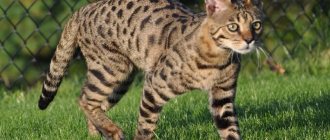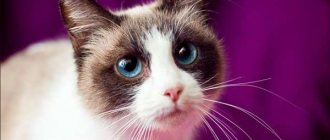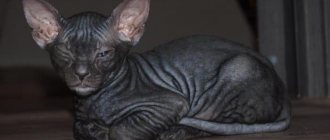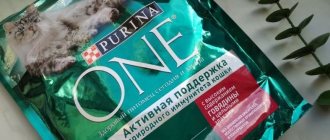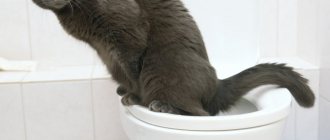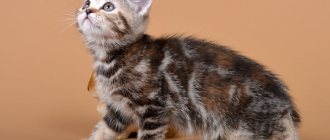Origin story
The history of the breed began at the end of 1987, on a simple farm in the USA. An ordinary yard cat gave birth to three kittens. One of the babies was noticeably different from the rest: he was smaller in size, and his fur was unusually soft and curly. The farm owner showed the kitten to breeder Jerry Newman. Newman liked the kitten so much that he took the baby to himself, and when the cat Miss Depesto grew up, he brought her together with his luxurious black Persian.
Of the six kittens in the litter, three turned out to be an exact copy of their mother: curly and with curled mustaches. Through long experiments, it turned out that the curly gene is dominant, which means that these cats can be recognized as a separate breed. Which is what happened in 1994.
Until 2015, Selkirk Rexes were crossed with Britons, Exotics and Persians, but then such connections were banned. Today the breed is recognized by such major organizations as ACF, WCF, CFA, TICA and ACFA.
It is best to buy a kitten from an official nursery or from a breeder with good reviews. At the bird market, you will most likely be deceived. Cats of this breed cannot be cheap: a baby for a family costs at least 15,000 rubles, and for breeding - from 35 and above. Choose an active and playful animal that is not afraid to come into your arms. It is advisable to look at the behavior of the baby’s parents. The seller is obliged to provide you with the kitten's birth certificate and a veterinary passport, which indicates the first vaccinations.
How to buy a Rex kitten
Affectionate and kind curly cats have become in demand among breeders all over the world. Now there are many nurseries where you can buy Rex kittens. Mostly such centers are located in large cities.
The price for a Selkirk Rex varies between 30,000 rubles. The cost depends on appearance, gender, age and existing pedigree. If you buy cheaper, you can get a kitten that does not have two purebred parents, so it will not be able to participate in exhibitions and earn titles.
To avoid making a mistake in choosing a pet, you need to:
- Look at the appearance;
- Monitor the kitten’s behavior and mood;
- Request pedigree and passport from the seller;
- Consider the age of the animal.
Standards
Selkirk rexes weigh a lot: females sometimes reach 6 kg, and males - 8-9.
| Standard | Description |
| Head | Skull: round, with smooth muzzle features. The cheeks are plump, as are the whisker pads, the eyebrows and mustache are curly. The forehead is round, smooth, the chin is powerful (but does not protrude). |
| Ears | Small, with sharp tips, widely spaced. |
| Eyes | Big and round. The color of the iris can be blue, green, yellow of all shades. Different eye colors are allowed for white individuals. |
| Torso | Powerful, with well-developed muscles, short neck and full chest. |
| Limbs | Medium length, slender, paws round and wide. The tail is wide, long, tapering towards the tip. |
| Wool | Dense, curly, with a very thick undercoat. It can be either medium or long. The formation of the coat occurs up to 2 years, and, having been born curly, by 10 months the kittens lose their curls for some time, and then become curly again. |
General characteristics of the breed
The TICA classification system gives the following description of “bear cubs”:
- Head. Round in shape, large, with round cheekbones. All lines are smooth, the forehead is wide, voluminous, rounded.
- The chin is strong, firm, rounded square.
- Nose. Short and relatively wide, with a pronounced break.
- Mustache and eyebrows. Curly or curly.
- Neck. Short, strong, solid, covered with curly hair.
- Ears. Medium size, widely spaced, large at the base, tapering at the top, smoothly rounded tips. The edge inside the ear is curly.
- Eyes. Large size, round, set wide apart. The color is usually characteristic of the coat color.
- Body. Strong, wide, muscular, squat, closer to the structure of a cobby.
- Paws. Medium length, muscular, wide, strong. The foot is round and thick.
- Tail. Medium-long, wide, slightly tapering towards the end and rounded out.
- Dimensions. Medium and large individuals. The male is much more powerful, the cats are smaller, but “grace” is not acceptable.
- Weight. Females - three to four, males - four to seven kilograms.
- Wool. The main hair and small undercoat are curly or slightly curly. Soft and silky to the touch. Curliness is most pronounced on the neck, abdomen and “pants”. Straight hair is also found in the cover. Short and long-haired individuals are acceptable. With a short coat, the undercoat is dense, the coat is wavy, and the ends of the hair are strongly curled. Long-haired cats have characteristic curls.
- Color. Any colors, spots, medallions are allowed. Eye color not matching coat color is acceptable.
- Crossbreeding. Only intrabreeding is allowed.
Flaws:
- excessively heavy body type;
- refined oriental bones;
- small, weak chin;
- muzzle too short or long;
- coat that is not wavy enough.
Disqualification:
- defects, tail breaks;
- polydactyly;
- cryptorchidism - failure of one or both testicles to descend into the scrotum;
- irregular eye structure - elongated or slanted;
- lack of curls.
All systems have noted that individuals are always born curly, in a few weeks the hair straightens, and by ten months the animal again has a completely curly coat. The final formation of the animal occurs by two years. The quality and waviness of the coat is determined by the degree of spontaneous mutation of the dominant gene.
Individuals born with straight hair are called Silkirk Straights.
The character of the Selkirk Rex turned out to be unusual due to such a large number of breeds that participated in the breeding of these “teddy bears”:
- silent;
- they like to play, but in moderation;
- affectionate, happy to be in the company of the owner and devoted to him;
- absolutely good-natured;
- make friends with other pets;
- not subject to stress;
- have a high level of intelligence.
The excessive gullibility of “sheep” makes them easy prey for vicious dogs, so you should not let these pets out into the street alone.
“Teddy bears” can charm any person. Every year this breed increases its popularity.
Character and behavior
Selkirk Rex cats are absolutely not afraid of people: both loved ones and strangers. To be at home everywhere is the motto these furry purrs adhere to. Their friendliness sometimes causes bewilderment: how can one be so trusting and sincerely confident in universal love? It turns out that it’s still possible. You still need to look for such cute and gentle creatures: even if you are not ready to devote time to your pet, he will not be offended, but will patiently wait for your affection. But if you are ready to communicate with them, they will show how happy they are.
Selkirk Rexes do not have a leader in the family: all members of the family, both big and small, are equally loved by them. The attitude towards children is very reverent: they happily play with the kids for hours on end, meekly endure changing clothes and being dragged from corner to corner, and will never bite a child if he unwisely hurts the animal.
Patience is another of the main qualities of this breed. Selkirk Rexes will not follow their owner’s tail, begging for attention and food, so you yourself need to be especially careful: is your pet hungry? But it is precisely thanks to the lack of demands and capriciousness that rexes quickly adapt to a new place of residence and get used to other living conditions.
There are usually no problems with education. Kids quickly get used to their new place of residence, remember house rules and obediently follow commands. But loneliness for them is the worst punishment. The Selkirk Rex should not be left alone for long periods of time. Even a regular 9 to 5 job is a bad option. Either someone should be in the house with the animal at all times, or you should get a cat of a different breed.
Rexes are not jealous, so you can easily have as many cats and dogs as you want. By the way, both birds and small rodents will be comfortable in your home. Rexes are not hunters, so they will be friends and not attack.
They love games and running around. They are able to make a toy out of everything around them, be it a thread, a paper ball or a feather. They will be happy to have a play complex with ladders and pipes in which you can climb to your heart’s content.
What is the difference between a pedigree and a passport?
- The passport indicates: Nicknames, age, breed and medical vaccinations. There is also a photograph of the animal.
- The pedigree contains pictures of the kitten's parents and their full data.
- If at least one kitten with a defect was born from these parents, then this is also indicated. Therefore, subsequent litters are subject to castration and sterilization.
Remember that at a young age, purebred Rexes do not have curly hair from four to ten months. Curls appear before the age of two. Therefore, the absence of curls on the coat at a certain age is considered normal.
Care instructions
Wool
The curly coat of the Selkirk Rex requires regular grooming. It doesn’t matter whether it’s long or medium. Buy a silicone mitten, a furminator and a brush with natural bristles - this will be enough. You need to brush your cat 2 times a week, and every 2 days during shedding.
Bathing
Bath - when the coat gets dirty, before giving birth or before an exhibition. You shouldn’t do this too often: the protective layer, being washed off the skin, leaves it defenseless against the aggressive external environment.
Use special cat cosmetics to care for your pet. The gels, shampoos and toothpastes we are used to, even for children, often cause allergic reactions and even poisoning.
Ears
The ears are wiped every week with a cotton swab dipped in ear lotion or boiled water.
Teeth
Brush your teeth once every 2 weeks with a soft toothbrush (you can take a regular baby brush and shorten the bristles by half) and cat paste. For preventive purposes, it is useful to drip a special cleansing gel with the taste of meat or herbs into drinking water, and once a year take the cat to the veterinarian for an examination and professional teeth cleaning.
Claws
A scratching post is a must-have attribute in the house. But your help will also be needed if the animal knows how to grind off its claws on its own. Once a week, carefully trim them without touching the skin and large vessels.
Do you trim your pet's nails?
Yes, he’s lazy with us. No, he sharpens himself.
Health
These pets are usually in good health from birth. Only three genetically inherited defects very rarely make themselves felt:
- a weak heart is a sore spot for the British;
- kidney pathologies - a defect of Persian cats;
- a tendency to conjunctivitis is a legacy of exotics.
With timely detection of diseases and proper maintenance of a plush cat, it is possible to cope with these problems.
Like every purebred cat, the “bear cub” needs:
- organize a complete balanced diet;
- treat external parasites twice a year;
- deworm once every three months;
- Vaccinate annually against rabies and all known feline viral infections.
Catering
If you want only the best for your pet, you cannot help but pay special attention to what and in what quantities he eats. Whatever you choose - ready-made food or a natural menu - choose fresh, high-quality products that do not contain artificial preservatives, dyes, GMOs and other harmful components.
Natural products
If you choose a natural menu, remember: you cannot feed your cat only meat. The diet should contain:
- Porridge (rice, oatmeal, buckwheat, semolina).
- Boiled vegetables (zucchini, pumpkin, carrots, asparagus, green beans).
- Vegetable oils (olive, flaxseed, sunflower).
- Fermented milk products (yogurt, sour cream, fermented baked milk, cottage cheese).
- Eggs.
You cannot give salty and sweet foods, smoked meats, seasonings, alcohol, bones (even boiled ones).
Recommended food
Industrial ready-made food is a real salvation for those who don’t have time or don’t like to cook. But don’t take just any food from the store shelf, and the price that’s too low should alert you. Get used to reading the labels on packages.
- Economy feed: Gemon, PROtail, TerraCat.
- Premium food: Club 4 Paws, Native food.
- Super premium: Guabi Natural, Landor, Leonardo, Monge.
- Holistic food: Now Fresh, One&Only, Orijen, Power of Nature, PureLuxe.
Super-premium and holistic foods are considered the best in the general food rating. In their production, natural preservatives and antioxidants, less allergenic sources of carbohydrates (rice, oats, barley), meat and fish, dried vegetables, berries, and vitamin and mineral supplements are used.
Below are the recommended foods. Links with the names of the food are clickable, on them you can, within our website, get acquainted with the descriptions of the food and read reviews from owners of Selkirk Rex cats.
| Holistic | Super premium | Premium |
| Nutram | Karmy | Safari |
The history of cats with curly hair
Typical domestic cats have two types of hair:
- awn or cover hair. Hard, straight and relatively long guard hair with a conical tip. Covering hair is intended for protection, including from getting wet.
- Undercoat or down. Soft, short and thin hairs surround and support the guard hairs, so there are 10 times more of them. Downy hairs are thin and crimped and are responsible for thermoregulation.
But in curly-haired cats, during the course of the mutation, the texture of the coat has changed: there is practically no hair, and the downy hairs curl into curls with varying degrees of elasticity.
Diseases
Since the ancestors of this breed are the British, Persians and exotics, they also gave the Selkirks a tendency to certain diseases. If your Selkirk is exotic (that is, his nose is as flat as a Persian's), he may occasionally suffer from runny nose and conjunctivitis, and snore in his sleep.
The next trouble is urolithiasis. It can be identified by characteristic signs: the cat begins to frequently run to the toilet, it is clearly uncomfortable for her to urinate, and traces of blood are noticeable in the urine. The cause of the disease may be a cold or poor diet.
Diseases of the knee and pelvic joints are another unpleasant “inheritance”. The first symptoms appear already at the age of six months: the kitten begins to walk differently, limp, and it is obvious that it is painful for him to move.
The most dangerous disease is hypertrophic cardiomyopathy. With this disease, changes occur in the heart muscle. The animal quickly gets tired, coughs, and suffers from shortness of breath. Death can occur at any moment. The disease cannot be cured, but it is quite possible to maintain the cat’s physical condition at a decent level.
Expert opinion
Dusheba Vera Ivanovna
In 2010, she graduated from the Moscow State Academy of Veterinary Medicine named after K.I. Scriabin with honors, specializing in veterinary medicine. I regularly attend veterinary conferences, congresses, and webinars.
There is an opinion that Selkirk Rex cats are hyperallergenic due to their fur. But this is a mistake: the allergy is not associated with fur, but with cat saliva.
Selkirk Rex Health and Diseases
The lifespan of the Selkirk Rex is 15-20 years. As for genetic diseases, their cats were provided with crossing with Persians, British and exotics. By inheritance from ancestors the following can be passed on to the breed:
- polycystic kidney disease;
- hip dysplasia;
- hypertrophic cardiomyopathy.
Fortunately, in recent years it has become less and less possible to purchase a pet with hereditary diseases: serious nurseries do not skimp on medical tests and do not sell defective kittens.
Photo gallery
Below are photos of Selkirk Rex cats.
Experimental and unrecognized breeds
This group includes representatives who have not yet received their approved standard. Breeding experiments are still ongoing, so all these animals are in their infancy.
American Rex
The largest number of experimental varieties is in the United States. There are rexes in almost every state:
- Oregon.
The Oregon Rex is a rare breed that lost its purebred status in 1972. To preserve the population, Cornish and Devons were involved in its breeding.
- Dakota.
The Dakota Rex standard is still being developed. The first experiments on their breeding began in 1991, but breeders never achieved the desired results.
- Tennessee.
Tennessee Rexes are notable for their satin coat that shimmers in the sun. Unlike other rexes, they have not only a downy undercoat, but also long outer hair.
- Missouri.
This cat confirmed the theory about the diversity of genes responsible for curls. His experimental crossbreeding with Cornish and Devon cats resulted in the birth of ordinary straight-haired kittens.
In addition to the representatives listed, there are others. All of them are united by a small population, which greatly complicates the work of breeders.
Dutch Rex
Curly cats have not escaped Holland either. Local felinologists believe that they originated from either the American Wirehair or the Maine Coon.
A distinctive feature of the Dutch Rex is its hard, wire-like coat. In all other representatives it is soft and silky.
Lambkin
Lambkin is the result of crossing a Selkirk Rex and a Munchkin under the guidance of an American breeder. From the first parent he inherited curly hair, and from the second - an elongated body with short legs.
Poodlecat
The homeland of this curly cat is Germany. When creating it, not two, but six breeds were used:
- Devon Rex;
- Scottish Folds;
- Norwegian forest;
- Maine Coons;
- Somalia;
- Chartreuse.
In the appearance of the Poodlecat, the graceful proportions of the Devon Rex and the curled ears of the Scottish are clearly visible. The litter also contains straight-eared kittens, which are sure to be used in subsequent matings. Mating of fold-eared animals with each other is strictly prohibited, as it leads to defects in bones and joints.
The preliminary standard of the Poodlecat is approved by FIFe. All other international organizations refuse recognition due to the small number of representatives.
Raffle
The Americans did their best here too. Ruffles are curly-haired cats obtained by hybridizing the American Curl and the Cornish Rex. From their first parent they received charming ears curled in the opposite direction.
Skookum (dwarf laperm)
Skookum is another breed of curly-haired cat bred in the USA. When creating this baby, as in the case of the lambkin, munchkins were also used. The second parent was Laperm.
INTERESTING!
Skookums are not afraid of water, so to maintain airiness and fluffiness of the hairs, they can be periodically wetted with a spray bottle.
The weight of adult animals reaches no more than 2-3 kg. Due to its miniature size and fluffy collar, the skookum began to be called the dwarf laperm.
Czech (Bohemian) Rex
The Czech Republic is the first country that managed to achieve successful results using the “Persians”. All other experiments led to the appearance of unkempt fur, requiring complex care.
The appearance of Czech Rexes is close to Persian cats. They are distinguished only by a peculiar curl. On the hips and chest it forms fluffy “pants” and a “collar”.
